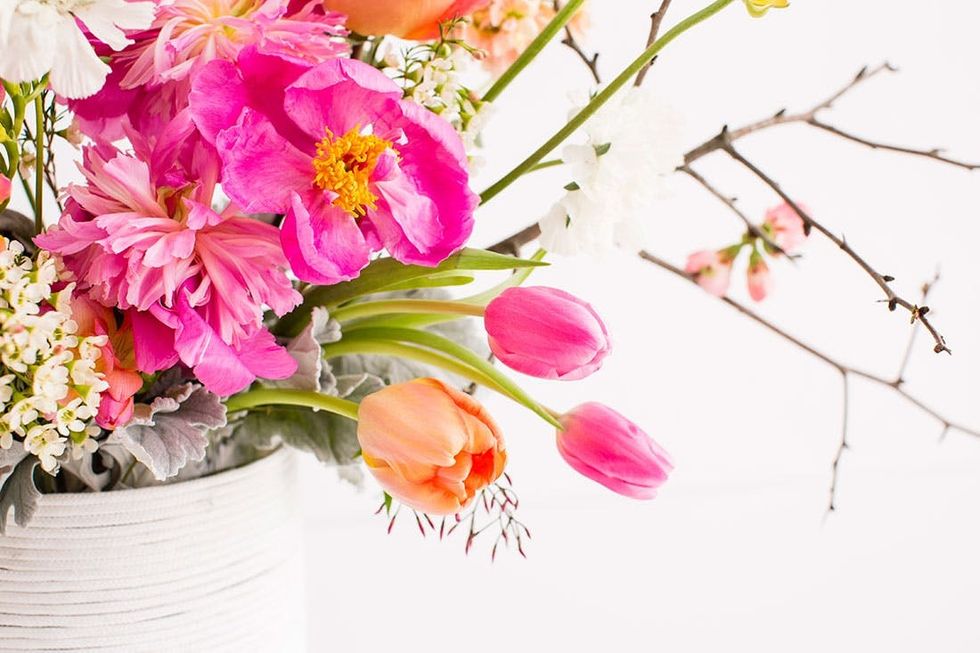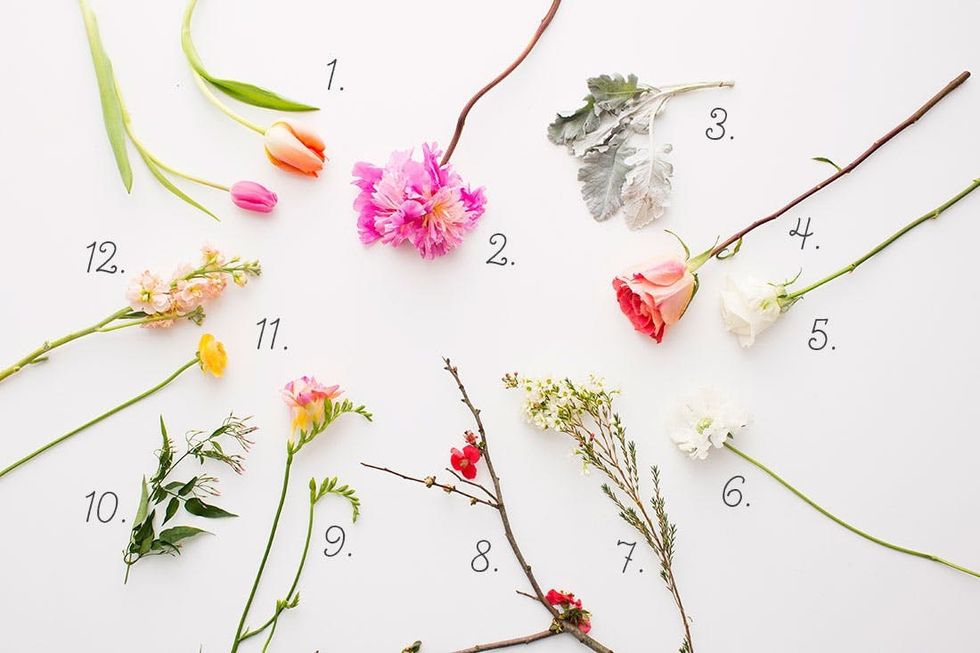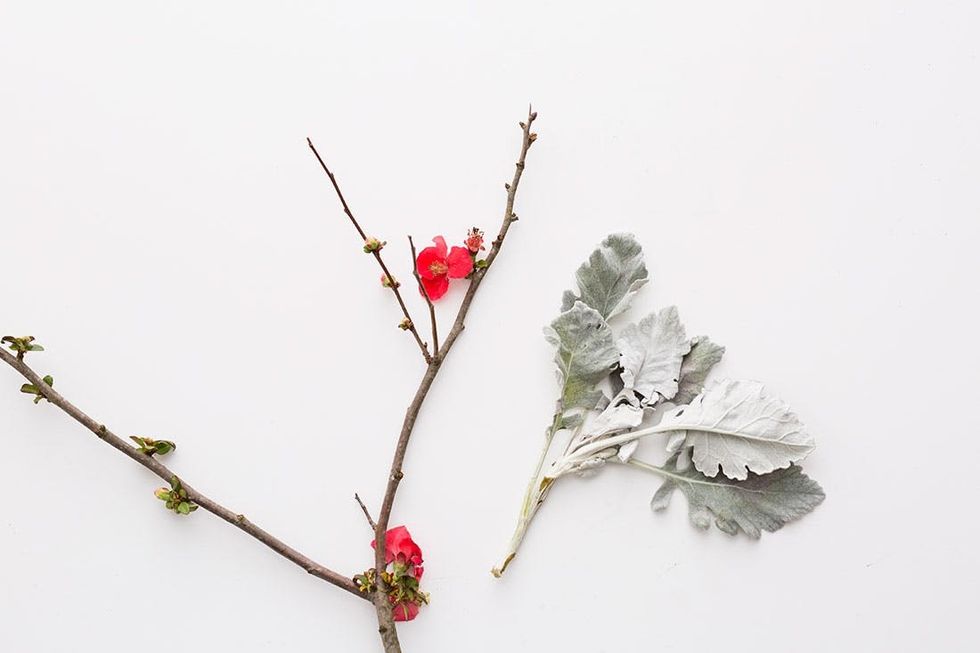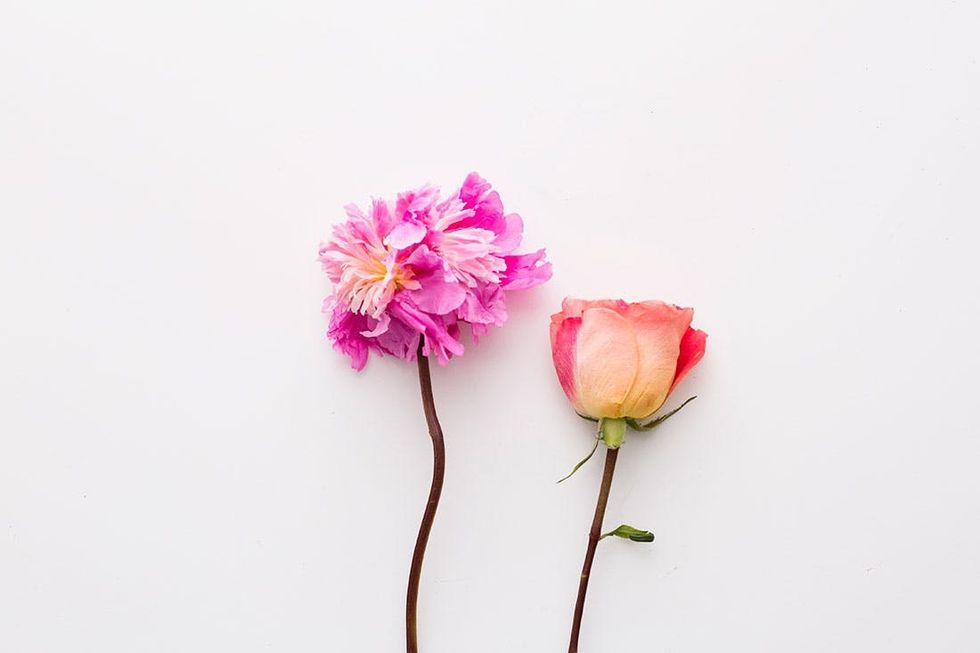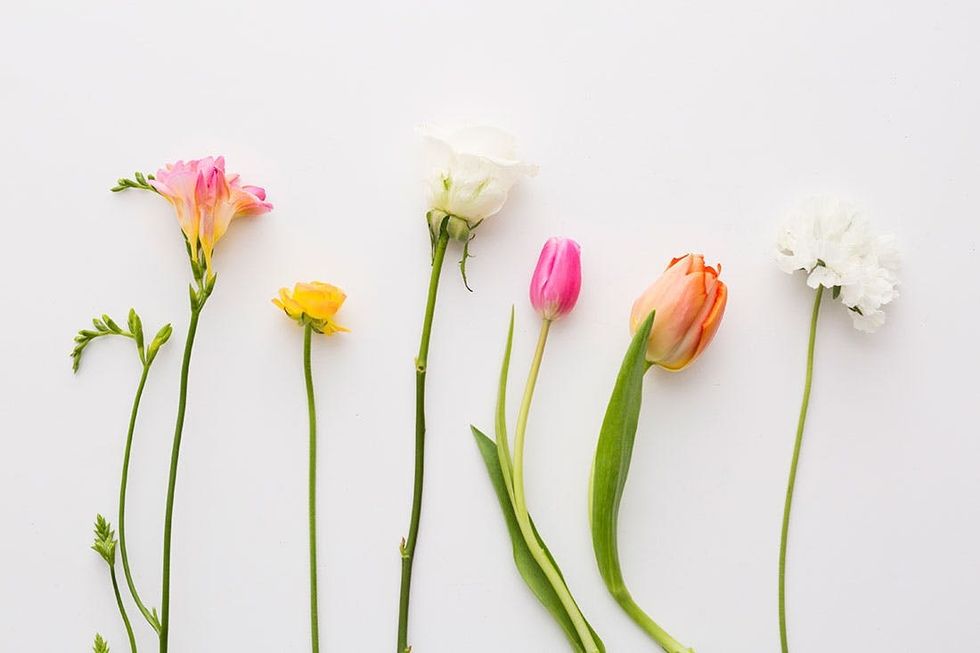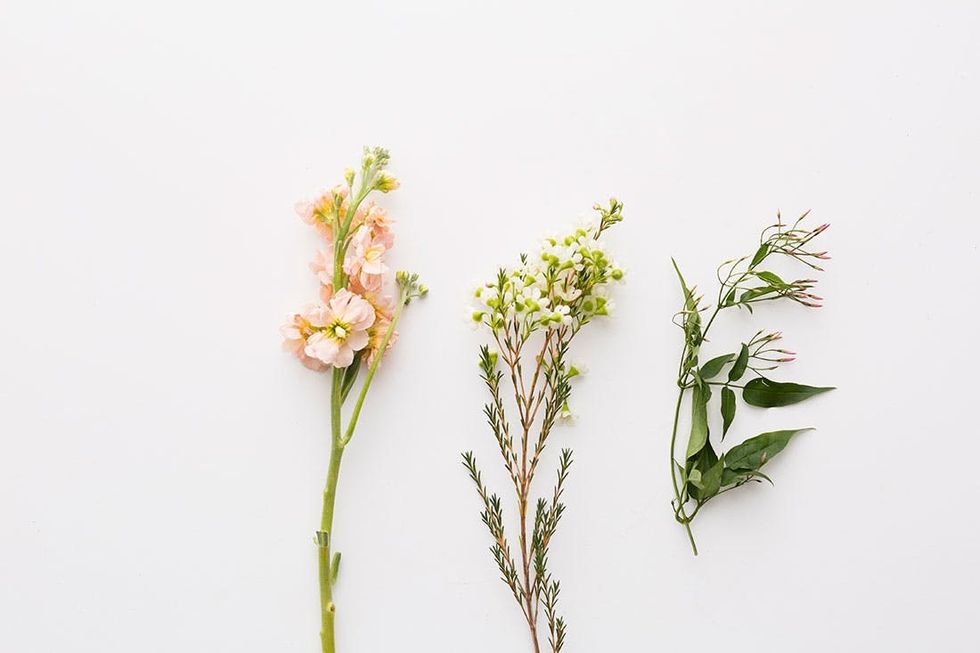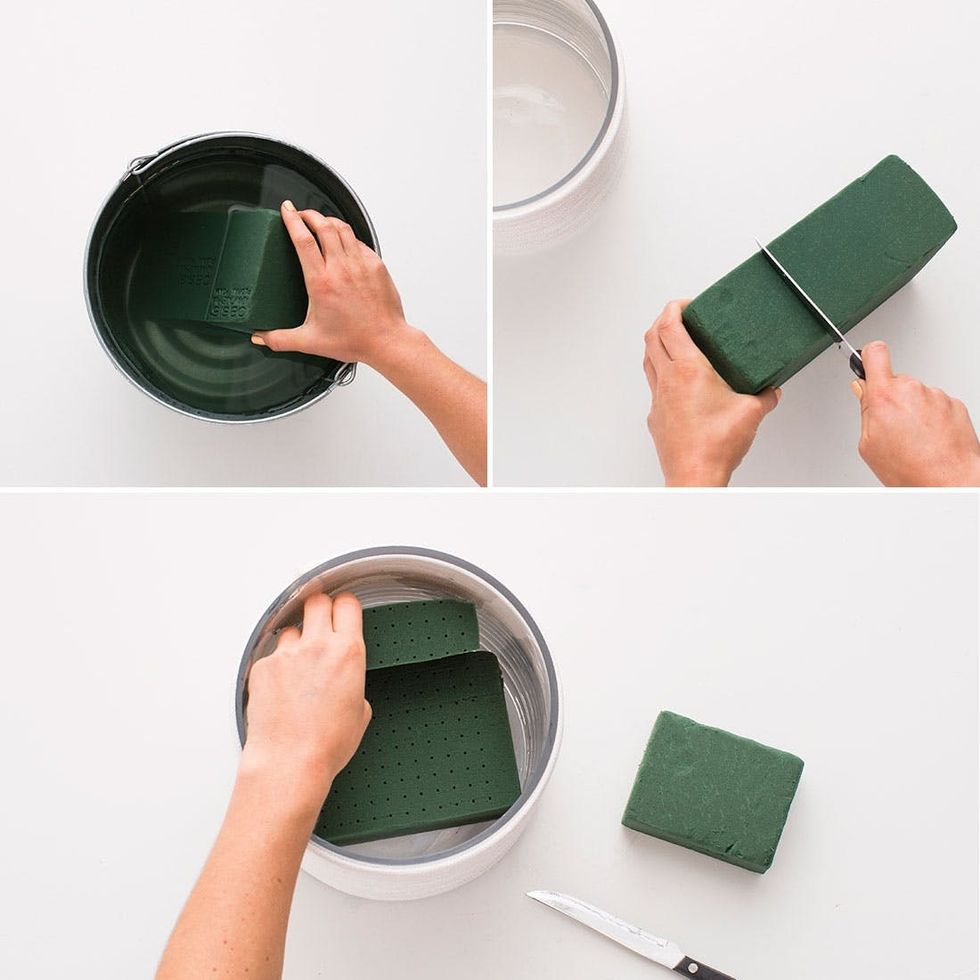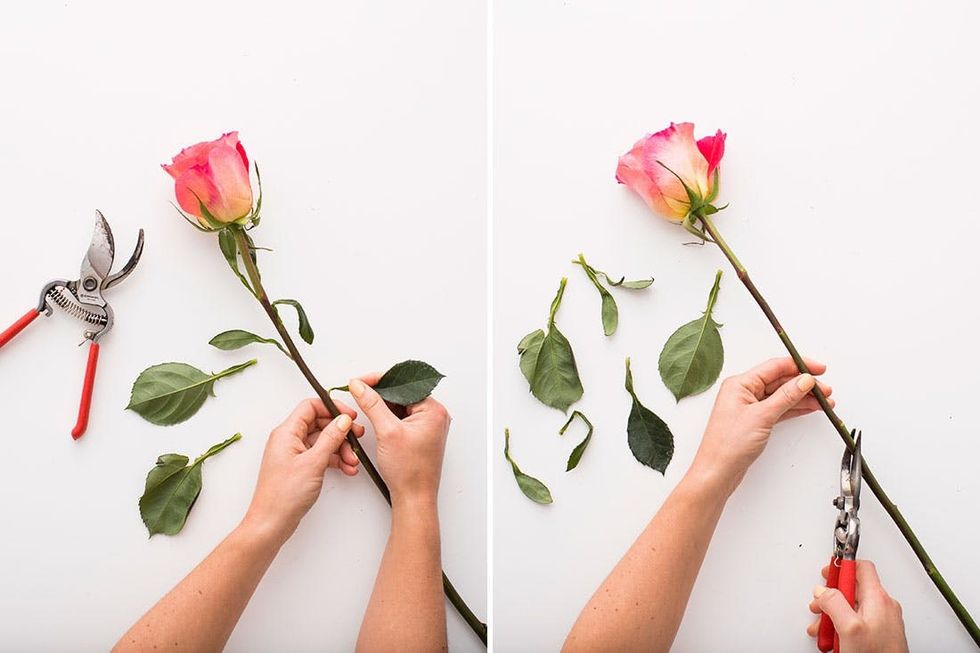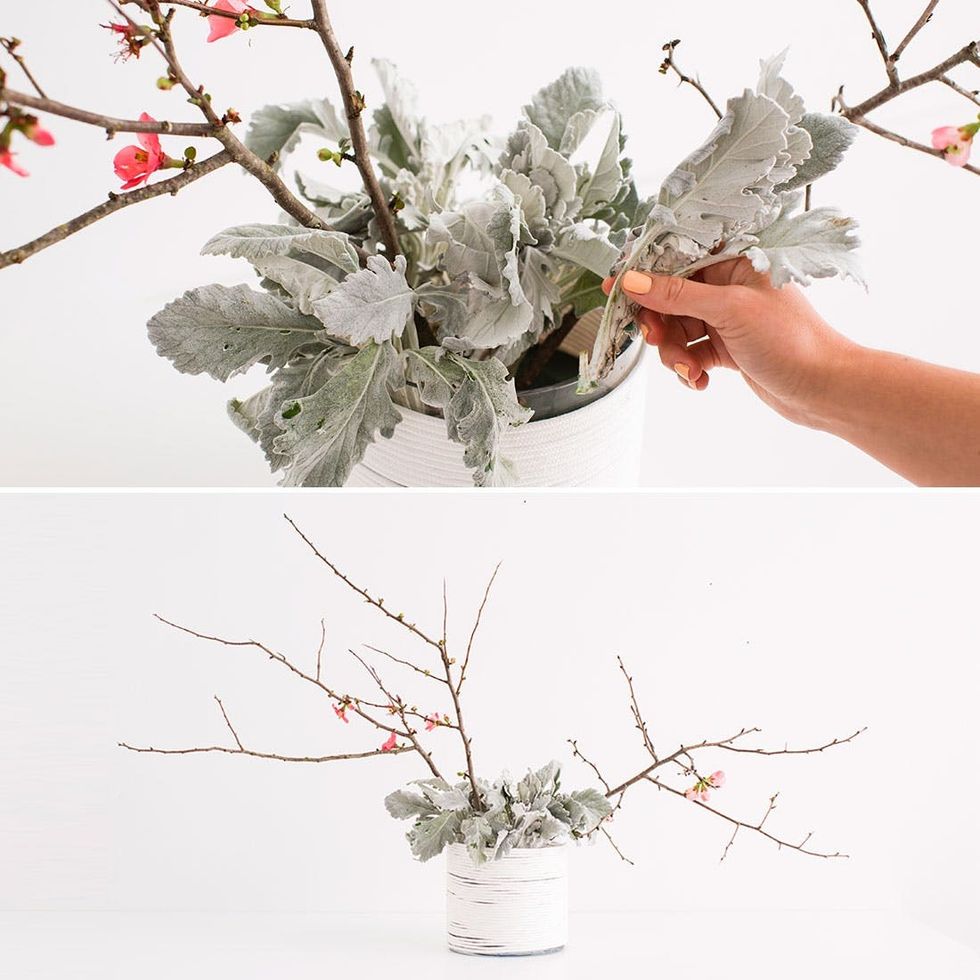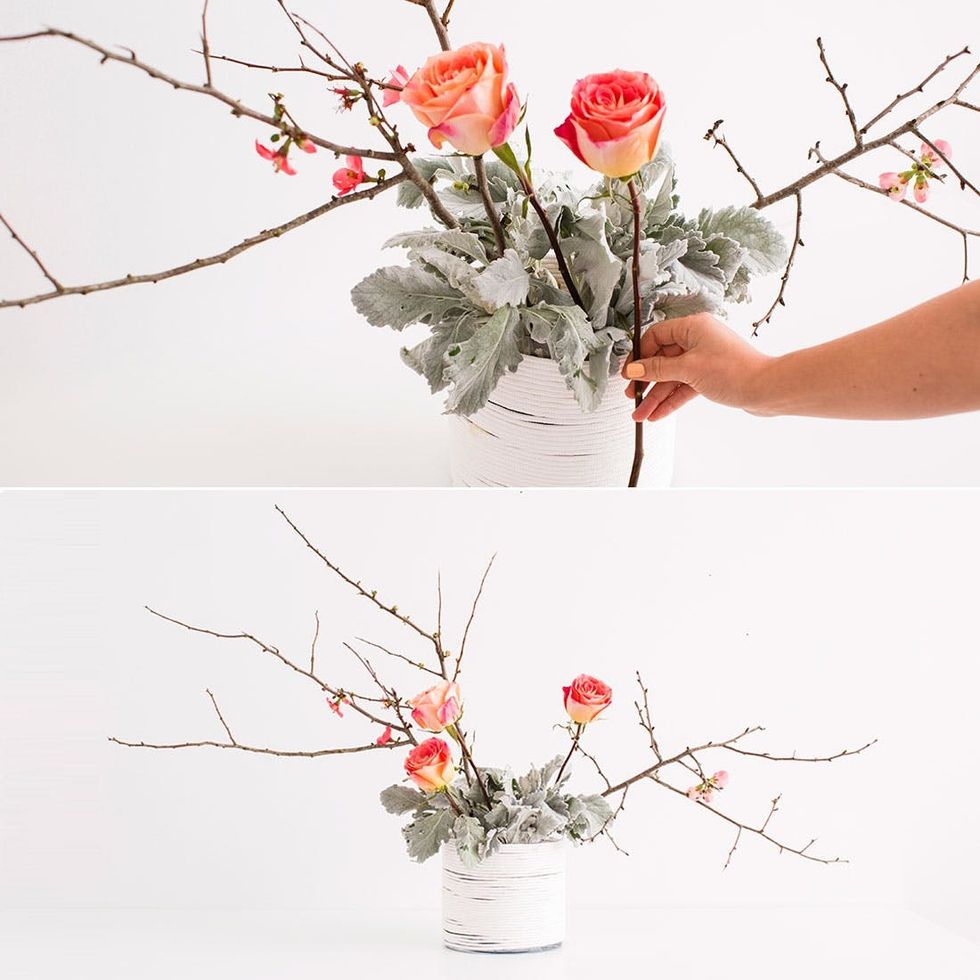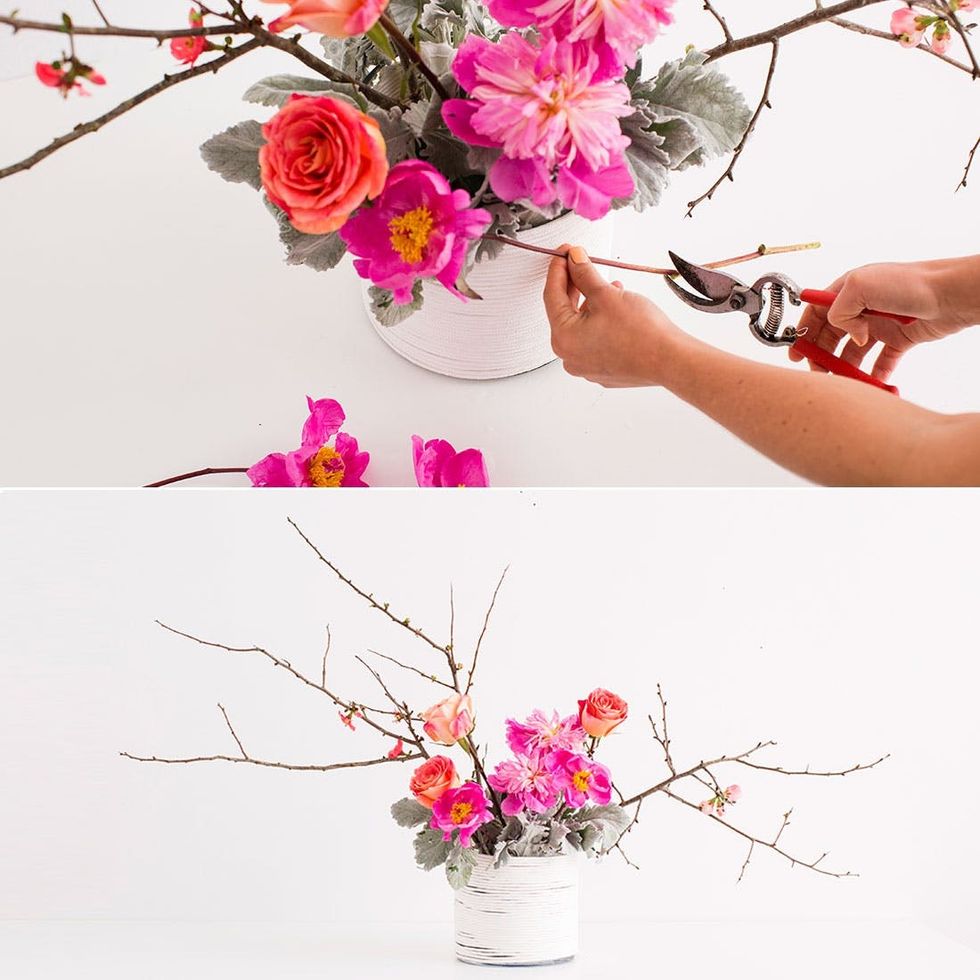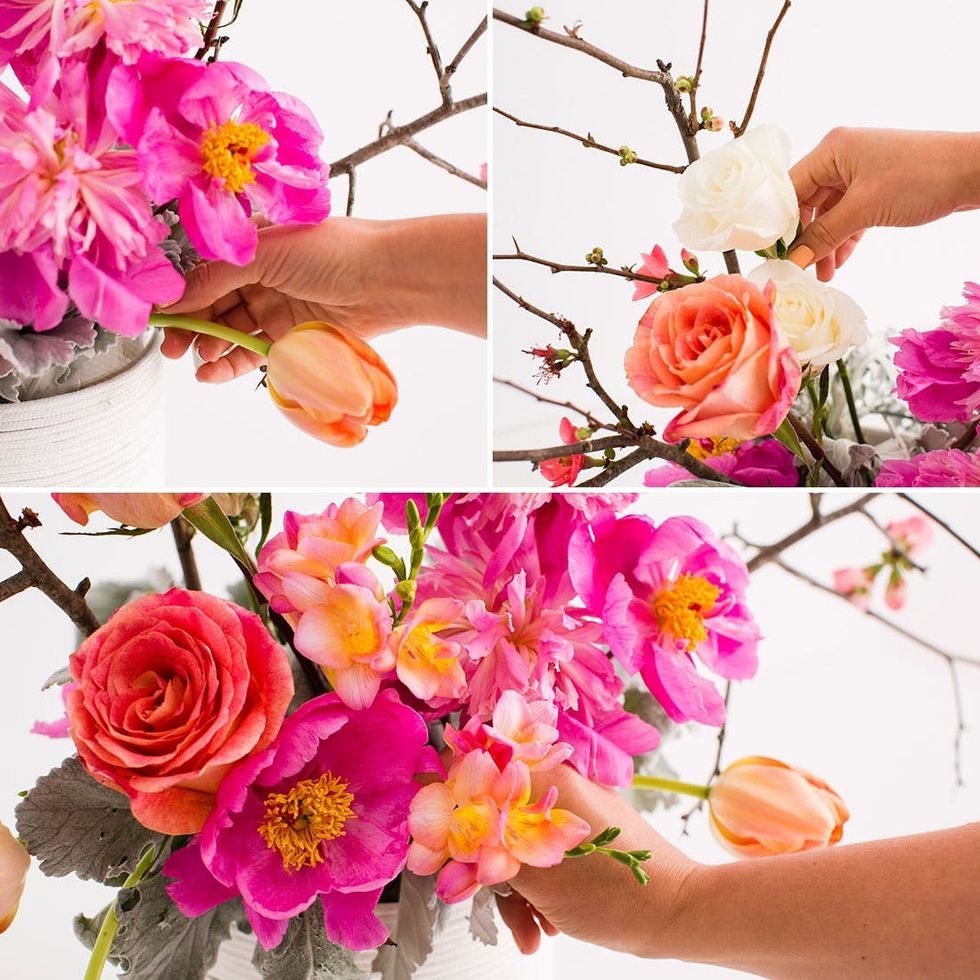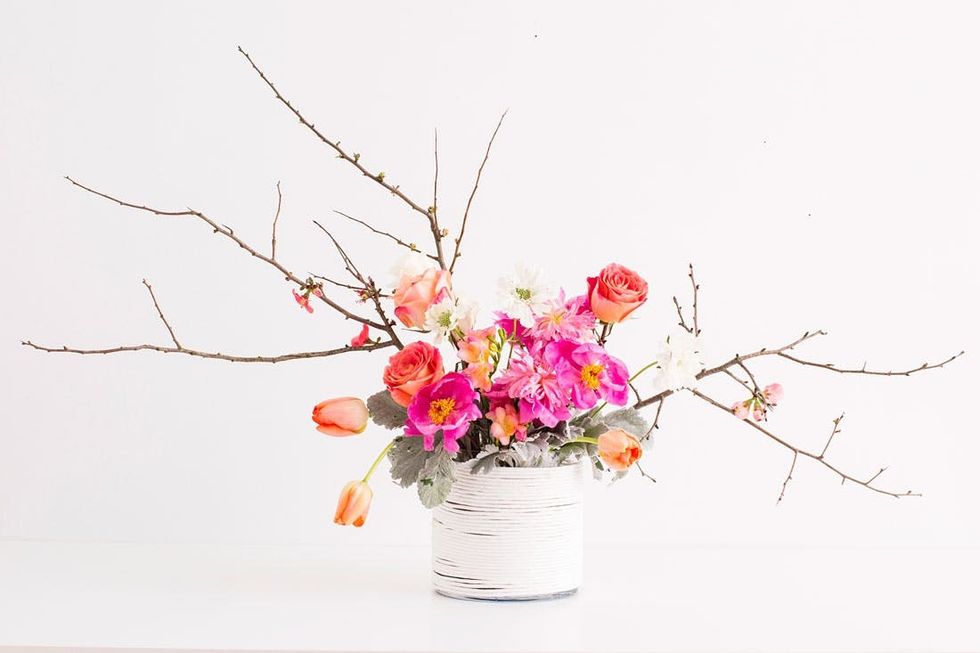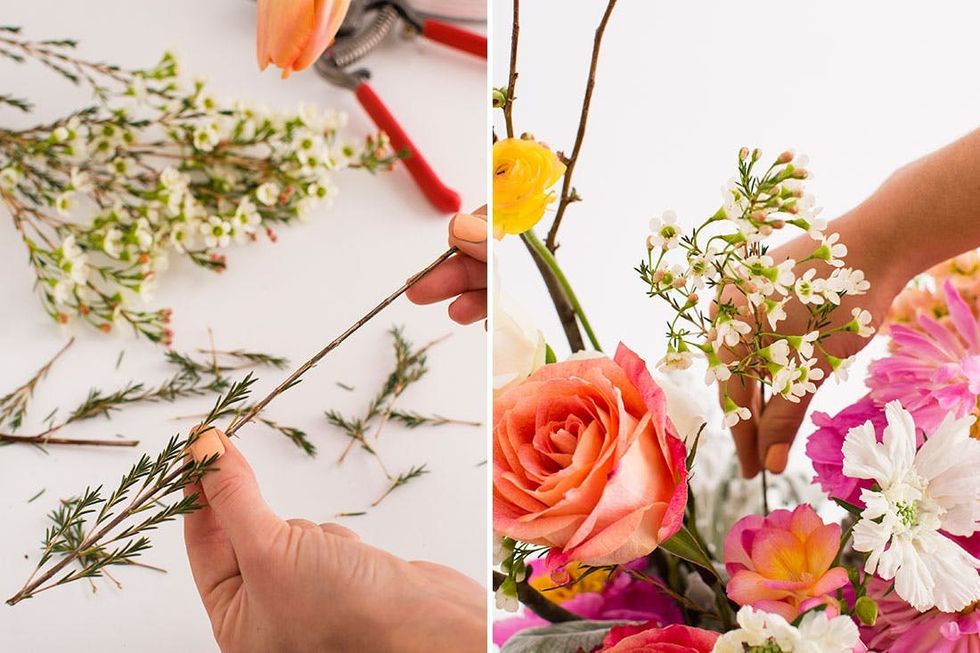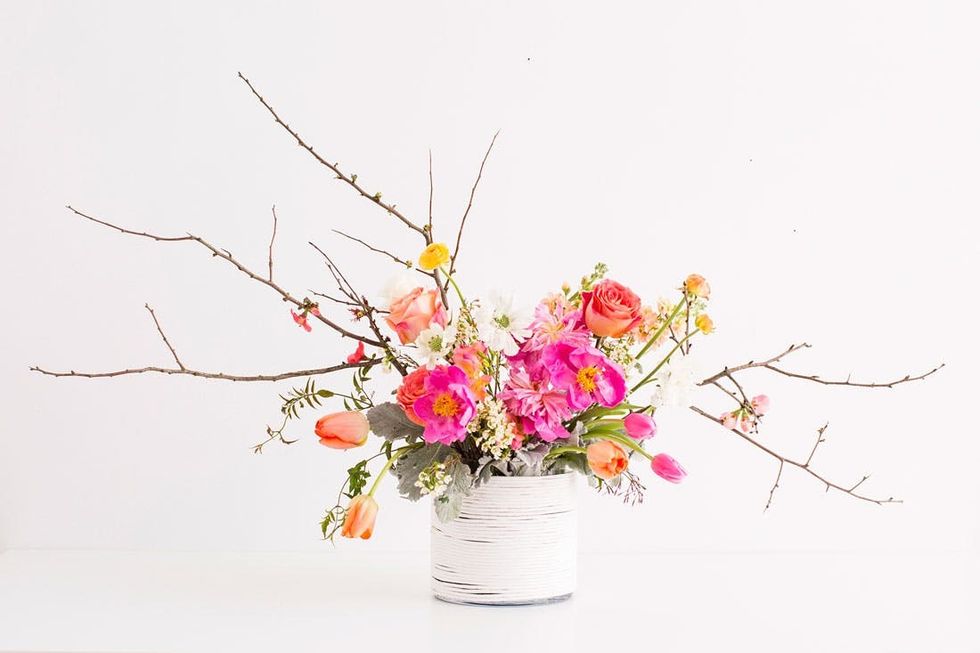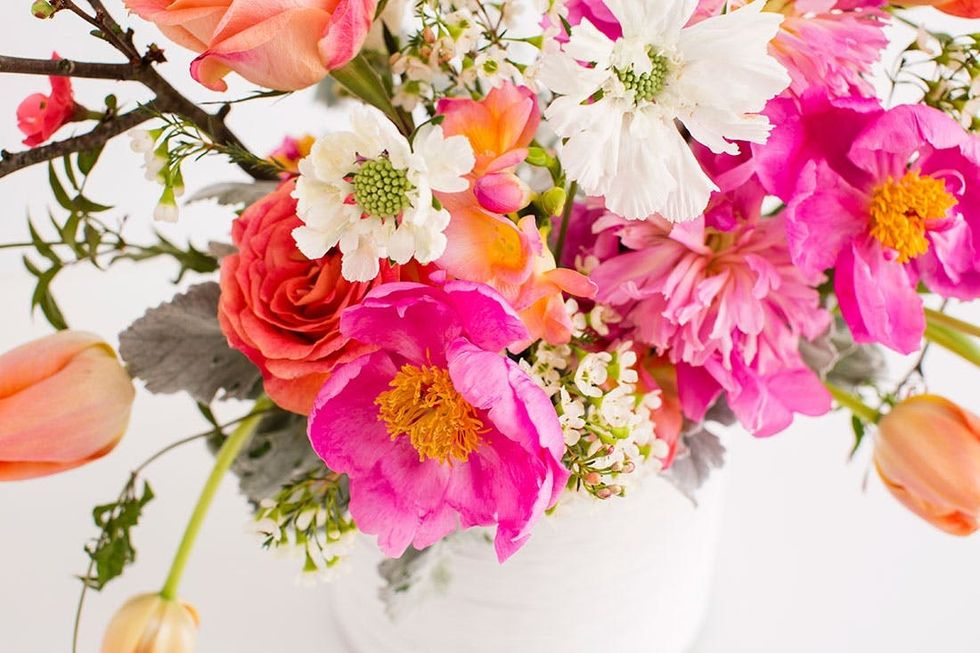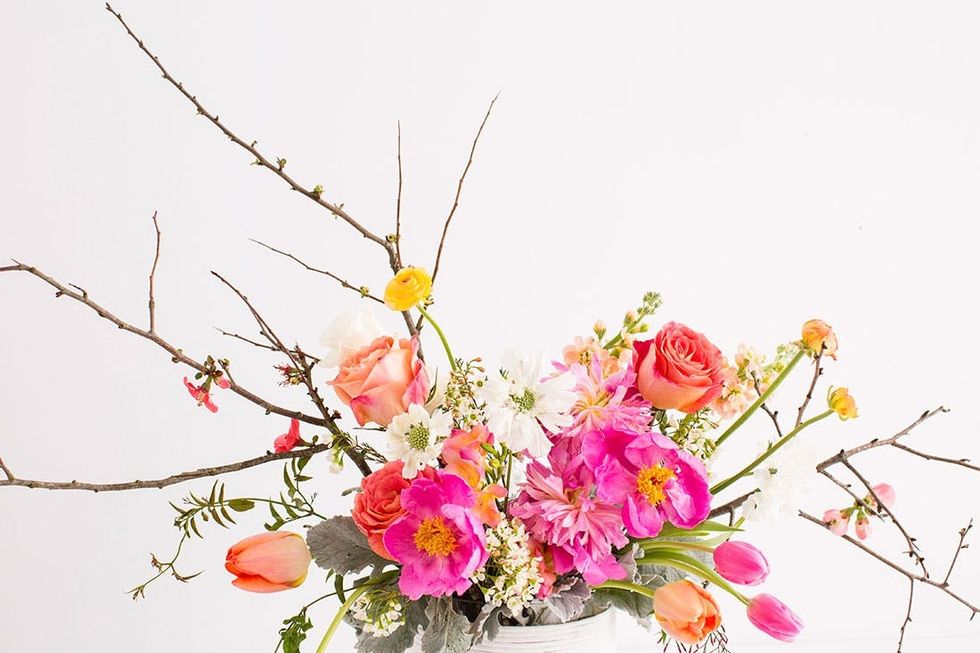Flowers are such a magical creation that can brighten up anyone’s day. A beautiful arrangement can transform a room and be an eye-catching, jaw-dropping piece. If you’ve always wondered how to arrange flowers but don’t know where to begin, don’t worry — we can help. The wonderful ladies of Farmgirl Flowers have created a 25-minute beginner Flower Arranging 101 class, which will teach you all you need to know about flowers and arranging. For now, we’ll walk you through the steps to create a gorgeous wild arrangement that will turn heads.
<br/>

– vase
– one block of oasis
Tools:
– floral shears
– knife
1. Tulips
Types of flowers
2. Peonies
3. Dusty miller
4. Roses
5. More roses!
6. Scabiosa
7. Wax flower
8. Flowering quince
9. Freesia
10. Jasmine
11. Ranunculus
12. Stock
When you’re choosing flowers for your arrangement, you’ll need to pick greens for the base, focal flowers, secondary flowers and fillers.
We used dusty miller and flowering quince as our base.
Our focal flowers were roses and peonies. These blooms are a bit larger than the others, so keep that in mind when you pick your focal flowers.
We have a lot of secondary flowers!
And some lovely little fillers.
Before you start arranging your flowers, you’ll need to prepare your vase. Soak the oasis in water until it is fully saturated. Then cut it to size with your knife. It’s okay if it doesn’t completely cover the bottom of the vase. Now fill your vase about halfway with water.
Next, you need to process your blooms. Remove the leaves and cut the stem at an angle. If you’re cutting a branch, you can make a snip in the stem to help it absorb water.
One technique to make your arrangement wild is to add branches. We went with flowering quince, which blooms in late winter. The branches are different lengths and are set in the oasis at different angles. This part is really important, as you are creating the structure for your arrangement. Pay attention to the placement of each branch. The story you are telling with these flowers starts now.
Next we added dusty miller. We placed the leaves in the oasis at different angles and created a shelf that will support the rest of our blooms.
Time to add your focal flowers. These are the blooms that will stand out and be the most eye-catching in the group. Look at the shape of the flower and add it to the arrangement in a way that highlights its beauty and enhances the overall shape of the arrangement.
Our second focal flower is a peony. It’s always a good idea to group your flowers. Rather than creating a polka-dotted look, put multiple flowers of the same type in a little pod. As you can see, we have three peonies together as a little team.
Now add your secondary flowers. Again, making small pods will keep your arrangement from looking spotted. Another tip for the wild look is to pull your flowers slightly away from one another. When all of the flowers are at the same level, you start getting that rounded look, which isn’t a bad thing, but it’s not going to result in an organic shape.
Looking good so far!
Finally, it’s time for the fillers. Check your arrangement for holes and fill them with your small, wispy blooms. This is also an opportunity to add to the wild look. Allow the flowers to flow in their natural direction and then place them where they fit the shape of your arrangement. Jasmine provides a great example. If you hold up a piece, you’ll see that the vine twists and turns in all directions. Don’t fight the natural curves. Use them to your benefit and place them where they will create some interest in your floral work of art.
Don’t forget to pull the blooms out just a hair so there is breathing room around each one. Allow a few to be substantially longer or shorter, to pop out rather than sinking into the arrangement. Create flow and don’t be afraid to let your flowers fall over the edge of the vase.
The beauty of flower arranging is that you can easily try again if you’re not happy with the shape at the end. Better yet, if you’re just learning, you could make an arrangement and then make a new one the next day with the same flowers. Keep practicing and enjoy your flowers!
These flowers are so gorgeous!
What are your favorite flowers? And who is your favorite floral designer? Share with us in the comments below.
From Your Site Articles
- Professional Tips For Floral Arrangements - Brit + Co ›
- These Are The 10 Most Popular Flowers In The U.S. - Brit + Co ›
Roxy Taghavian
Roxy has been creating and executing DIY projects since her very first trip to Michael's as a child. If there's a project at hand, she'll figure out how to make it. When she's not wielding her hot glue gun, she can be found at the beach, traveling to far off lands, reading and running at her gym "The Panhandle."
Insights, advice, suggestions, feedback and comments from experts
I'm a passionate enthusiast with a deep understanding of floral arrangements and the art of flower design. I've spent years studying and practicing the art of arranging flowers, experimenting with different types of flowers, vases, and techniques to create stunning and eye-catching floral displays. My expertise extends to understanding the characteristics of various flowers, the principles of floral design, and the techniques for creating different styles of arrangements, from classic to wild and organic. I've also closely followed the work of renowned floral designers and have a keen eye for the latest trends and innovations in the world of floral artistry.
Flower Arranging 101: Creating a Gorgeous Wild Arrangement
The process of creating a stunning wild flower arrangement involves several key steps and considerations. Let's break down the essential concepts used in the article and provide insights into each aspect.
Types of Flowers
- Tulips, Peonies, Dusty Miller, Roses, Scabiosa, Wax Flower, Flowering Quince, Freesia, Jasmine, Ranunculus, Stock: These are the various types of flowers mentioned in the article that can be used to create a wild flower arrangement.
Choosing Flowers for the Arrangement
When selecting flowers for an arrangement, it's important to consider the following categories:
- Base, Focal, Secondary, and Fillers: These categories help in organizing the selection of flowers for the arrangement. Dusty miller and flowering quince were used as the base, while roses and peonies were chosen as focal flowers. The arrangement also included secondary flowers and fillers.
Preparing the Vase
- Soaking the Oasis and Cutting to Size: The oasis, a floral foam, should be soaked in water until fully saturated and then cut to size with a knife. The vase should be filled halfway with water.
Arranging the Flowers
- Adding Branches and Creating Structure: Branches, such as flowering quince, can be added to create the structure of the arrangement. The placement of each branch is crucial in establishing the foundation of the arrangement.
- Incorporating Dusty Miller: Dusty miller can be used to create a supportive shelf for the other blooms in the arrangement.
- Placing Focal Flowers: Focal flowers, such as roses and peonies, should be added in a way that highlights their beauty and enhances the overall shape of the arrangement.
- Including Secondary Flowers: Secondary flowers should be added in small pods to maintain a natural and organic look. It's important to avoid creating a polka-dotted appearance and to pull the flowers slightly away from one another to achieve an organic shape .
- Adding Fillers: Fillers, such as jasmine, can be used to fill any gaps in the arrangement and add to the wild and natural look. It's essential to allow the flowers to flow in their natural direction and create breathing room around each one.
Final Touches and Practice
- Creating Flow and Organic Shape: It's important to allow some flowers to fall over the edge of the vase and to create flow within the arrangement. Additionally, the beauty of flower arranging lies in the ability to try again and practice until satisfied with the result .
Favorite Flowers and Floral Designers
As for my favorite flowers, I have a soft spot for peonies and ranunculus due to their delicate and intricate petals. When it comes to floral designers, I greatly admire the work of Sarah Winward for her natural and organic approach to floral design. Her ability to create arrangements that feel like they've been effortlessly gathered from a wild garden is truly inspiring.
Feel free to share your favorite flowers and floral designers as well!
